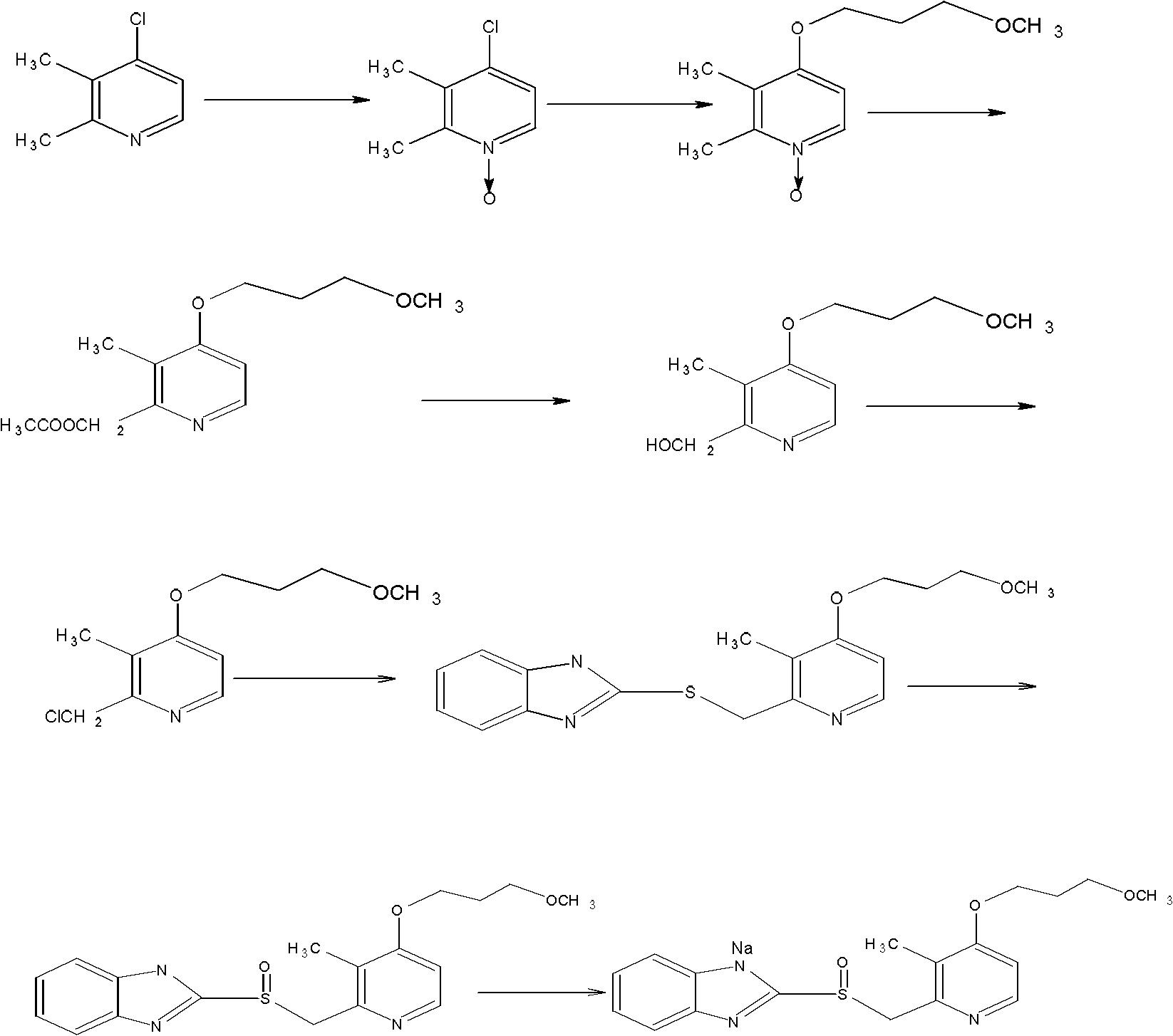Preparation method of rabeprazole and sodium salts thereof
A technology of rabeprazole and benzimidazole, which is applied in the field of preparation of rabeprazole and rabeprazole sodium, can solve the problems of many by-products, sources of oxidants, and low yield, and achieve moderate cost and post-treatment Simple operation and high yield
- Summary
- Abstract
- Description
- Claims
- Application Information
AI Technical Summary
Problems solved by technology
Method used
Image
Examples
Embodiment 1
[0029] Add 250 g of dried methylene chloride to a 1L three-necked reaction flask, and then add 100 g of 2-[[[4-(3-methoxypropoxy)-3-methyl-2-pyridyl]-methyl ]Sulfuryl]-1H-benzimidazole, stir to dissolve, slowly add 35g of oxidant PCC at 5-10°C, after addition, keep the temperature between 20-25°C for 2h, add 300ml of water after the reaction, mix well, and use 1N Adjust pH=9 with sodium hydroxide solution, separate layers, extract the aqueous layer with 100ml of dichloromethane, combine the dichloromethane layers, wash the dichloromethane layer with 200ml×3 saturated brine, dry over anhydrous sodium sulfate, and concentrate under reduced pressure To dryness, 250 ml of acetone was added to the residue for recrystallization, filtered, the filter cake was washed with a small amount of acetone, and dried under reduced pressure to obtain 101 g of white solid rabeprazole.
[0030] Add the obtained rabeprazole into a 1000ml reaction flask, add 400ml of ethanol, adjust the pH=13 with ...
Embodiment 2
[0032] Add 300 g of dried chloroform to a 1L three-necked reaction flask, and then add 100 g of 2-[[[4-(3-methoxypropoxy)-3-methyl-2-pyridyl]-methyl] Sulfuryl]-1H-benzimidazole, stir to dissolve, slowly add 60g of oxidant PDC at 5-10°C, after the addition, keep the temperature between 10-20°C for 2.5h, after the reaction, add 300ml of water and mix well, use 1N Adjust pH=9.5 with sodium hydroxide solution, separate the layers, extract the aqueous layer with 100ml chloroform, combine the chloroform layers, wash the chloroform layer with 200ml×3 saturated brine, dry over anhydrous sodium sulfate, and concentrate under reduced pressure To dryness, 250 ml of ethyl acetate was added to the residue for recrystallization, filtered, the filter cake was washed with a small amount of ethyl acetate, and dried under reduced pressure to obtain 97 g of white solid rabeprazole.
[0033] Add the obtained rabeprazole into a 1000ml reaction flask, add 400ml of methanol, adjust the pH=12.5 with ...
Embodiment 3
[0035] Add 250 g of dried methylene chloride to a 1L three-necked reaction flask, and then add 100 g of 2-[[[4-(3-methoxypropoxy)-3-methyl-2-pyridyl]-methyl] Sulfuryl]-1H-benzimidazole, stir and dissolve, slowly add 70g of oxidant chromium trioxide pyridine at 5-10°C, after the addition is complete, slowly raise the temperature to 40-45°C for 3.5h, add water 300ml after the reaction Mix well, adjust the pH to 9.5 with 1N sodium hydroxide solution, separate the layers, extract the aqueous layer with 100ml of dichloromethane, combine the dichloromethane layers, wash the dichloromethane layer with 200ml×3 saturated brine, and anhydrous sulfuric acid Dry over sodium, concentrate to dryness under reduced pressure, add 350 ml of acetone to the residue for recrystallization, filter, wash the filter cake with a small amount of acetone, and dry to obtain 92 g of white solid rabeprazole.
[0036] Add the obtained rabeprazole into a 1000ml reaction flask, add 300ml of ethanol, adjust the...
PUM
 Login to View More
Login to View More Abstract
Description
Claims
Application Information
 Login to View More
Login to View More - R&D
- Intellectual Property
- Life Sciences
- Materials
- Tech Scout
- Unparalleled Data Quality
- Higher Quality Content
- 60% Fewer Hallucinations
Browse by: Latest US Patents, China's latest patents, Technical Efficacy Thesaurus, Application Domain, Technology Topic, Popular Technical Reports.
© 2025 PatSnap. All rights reserved.Legal|Privacy policy|Modern Slavery Act Transparency Statement|Sitemap|About US| Contact US: help@patsnap.com



